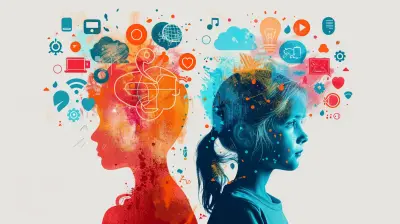Immersive Learning: The Power of Context in Acquiring a Second Language
27 June 2025
Have you ever tried learning a second language and found yourself stuck memorizing boring vocabulary lists or repeating grammar drills that just don’t stick? If so, you’re not alone. Traditional language learning methods often miss one crucial element: context. That’s where immersive learning steps in—and trust me, it can change everything.
In this article, we’re diving deep into how immersive learning works, why context is king, and how you can use it to skyrocket your language skills. Let’s break it all down in a way that actually makes sense—and might even make you excited to learn that second language you’ve always wanted to master.

What is Immersive Learning Anyway?
Before we jump ahead, let’s clear up what we mean by “immersive learning.”Think back to how you learned your first language. Did anyone hand you a grammar book when you were a toddler? Nope. You soaked it in naturally—talking, listening, observing, and mimicking everything around you. That’s immersion.
In a nutshell, immersive learning is about diving into the language—surrounding yourself with it in real-life contexts, not isolated lessons. It’s learning through experience, not just instruction.

The Role of Context in Language Learning
Imagine trying to understand the word “bark” without any context. Are we talking about a dog or a tree? That’s the problem with traditional language learning—it often leaves you guessing.Context acts like a GPS for your brain. It tells you where you are, what’s happening, and what everything means. When you're immersed in a situation—say, ordering food in a Spanish-speaking café—you don’t just learn the word “comida,” you tie it to an experience. And guess what? That mental link is what helps the word actually stick.
Why Context Matters
- Words become real: Abstract vocabulary becomes tangible when experienced in a relevant setting.- Grammar feels natural: Instead of memorizing rules, you see (and hear) how sentences are formed.
- Your brain connects faster: Context helps your brain associate new info with things it already knows.

Comparing Traditional vs. Immersive Language Learning
Let’s look at a quick comparison to see how immersive learning stacks up:| Aspect | Traditional Learning | Immersive Learning |
|--------|----------------------|--------------------|
| Learning Style | Theoretical | Practical |
| Vocabulary Retention | Lower | Higher |
| Grammar Understanding | Rule-Based | Pattern-Based |
| Engagement | Often Passive | Highly Active |
| Real-Life Usage | Limited | Constant |
See the difference? With immersive learning, you’re not just memorizing words—you’re living the language.

How Does Immersive Learning Actually Work?
Okay, so how do you turn your daily life into a second-language classroom? Here are some legit ways to immerse yourself, even if you’re not currently living in another country.1. Surround Yourself with the Language
The easiest way to start? Change your environment.- Change your phone or laptop language settings
- Follow social media accounts in the target language
- Watch movies or shows with subtitles
- Listen to podcasts or music daily
Trust me, the more you're exposed, the more your brain adapts—like a sponge soaking up water.
2. Speak from Day One
Afraid of making mistakes? Don’t be. Speaking early trains your brain and builds confidence faster than studying alone ever could.Use language apps with voice recognition, join local language meetups, or find a language exchange partner online. Even talking to yourself in the mirror helps!
3. Learn Through Real-Life Scenarios
Roleplay situations you’d actually face—shopping, ordering food, introducing yourself, asking directions. When you use the language in context, your memory goes into overdrive.Apps like Duolingo or Babbel are starting to use this technique more, but nothing beats real conversation or simulation.
4. Travel or Use Virtual Reality
Traveling abroad? That’s the ultimate immersion. But if hopping on a plane isn’t an option, virtual reality (VR) is stepping up as the next best thing. Platforms like Mondly VR or ImmerseMe let you practice speaking in interactive environments like restaurants, hotels, or streets.It’s like teleporting your brain into another country.
5. Think in the Language
This one might sound weird, but it works wonders.Start small—label objects in your house with sticky notes in your target language. Then, try describing your day or your thoughts in that language, even in your head. It gets easier with time, promise.
6. Make Mistakes—Lots of Them
Here’s a little secret: mistakes are your superpower. Every time you mess up, your brain learns what not to do. Embrace errors as stepping stones instead of roadblocks.The Science Behind Context-Based Learning
Alright, if you’re the type who needs some brain-based evidence, here’s the deal.Studies show that our brains remember information better when it’s contextually meaningful. When you learn vocabulary within a story, image, or situation, your brain builds neural connections that make recall easier and faster.
Neuroscientists call this semantic encoding, and it’s like giving your memory a highway instead of a dirt road.
Benefits of Immersive Learning for Language Acquisition
Still wondering if immersion is worth the effort? Let’s count the perks.1. Faster Fluency
When you constantly engage with the language, your brain adapts to speaking and understanding it more quickly. You’re not just a student—you’re a participant.2. Better Pronunciation
Hearing native speakers all the time tunes your ear to the proper sounds, rhythm, and intonation. It’s like music training for your mouth.3. Increased Confidence
Using the language in everyday situations builds practical confidence. That awkward moment of asking for directions? It turns into a win when someone responds—and you understand!4. Improved Memory Retention
Because you’re learning through experience, vocab and grammar stick around longer. You remember that “gracias” means thank you not because you memorized it, but because someone smiled and replied when you said it.5. Cultural Understanding
Language isn’t just words—it’s culture, humor, history, pop references. Immersion teaches you how people think and feel—not just what they say.Common Myths About Immersive Language Learning
Hold up—before we go further, let’s bust a few myths.“I have to move abroad to immerse myself.”
Nope! While living in a country where your target language is spoken can help, it’s not essential. You can create immersion at home with media, conversation apps, and a bit of creativity.“I need to be fluent before I practice speaking.”
Wrong again. Immersion is for all levels. The more you practice imperfectly, the faster you improve.“It’s only for young learners.”
Absolutely false. Adults can benefit just as much—even more, because they can connect new language to past experiences more effectively.Tips to Maximize Your Immersive Experience
Wanna make the most of it? Follow these quick tips:- Stay consistent—even 15 minutes a day can work wonders.
- Mix up your tools (TV, books, apps, conversations).
- Set tiny goals (like ordering food in your target language).
- Celebrate small wins to stay motivated.
- Don’t obsess over perfection. Fluency is messy at first.
Real-Life Success Stories
Still not sure this works? Let me share a few stories:- James, a 35-year-old accountant, learned Italian by watching Netflix without subtitles and FaceTiming a friend from Rome twice a week. In six months, he was conversational.
- Aisha, a college student, joined an online Spanish cooking class. Learning recipes in Spanish gave her the context she needed—and taught her some killer paella skills.
- Mark, a retiree, used VR immersion tools to learn Japanese. He practiced daily in virtual cafés and train stations. Two years later, he visited Tokyo—and navigated with confidence.
What do they all have in common? Context. Experience. Immersion.
Final Thoughts
If you’ve been struggling with language learning, maybe the problem isn’t you—it might be how you're learning.Immersive learning rewires the way we acquire a second language. It makes the process more natural, more fun, and—most importantly—more effective. By wrapping your brain in the sights, sounds, and rhythms of a new language, you give yourself the best possible shot at fluency.
So why not start today? Change that Netflix language setting. Talk to your language exchange partner. Label your fridge in French. Whatever you do, remember—context is your secret weapon.
You’ve got everything you need to succeed. Time to dive in.
all images in this post were generated using AI tools
Category:
Second Language AcquisitionAuthor:

Anita Harmon
Discussion
rate this article
1 comments
Lillian Gilbert
Context enhances language learning; immersion truly makes a difference.
July 24, 2025 at 3:08 AM

Anita Harmon
Thank you for your insightful comment! I completely agree—immersion provides invaluable real-world context that significantly enhances language acquisition.


